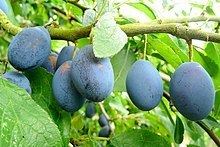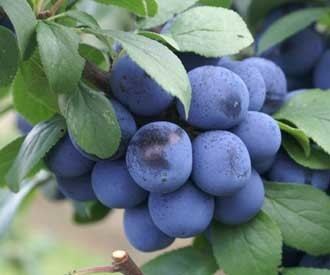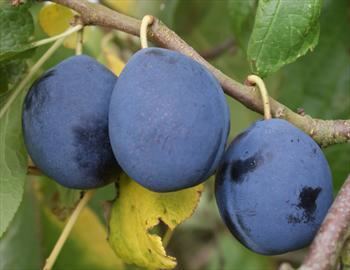Subgenus P. subg. Prunus | Genus Prunus Section P. sect. Prunus Rank Subspecies | |
 | ||
Similar Greengage, Sugar, Plum, Common plum, Cherry plum | ||
Prunus domestica
The damson (/ˈdæmzən/) or damson plum (Prunus domestica subsp. insititia, or sometimes Prunus insititia), also archaically called the "damascene" is an edible drupaceous fruit, a subspecies of the plum tree. Varieties of insititia are found across Europe, but the name "damson" is derived from and most commonly applied to forms which are native to Great Britain. Damsons are relatively small plum-like fruit with a distinctive, somewhat astringent taste, and are widely used for culinary purposes, particularly in fruit preserves or jam.
Contents
- Prunus domestica
- The damson or damson plum also archaically called the damascene
- History
- Characteristics
- Cultivars
- White damson
- Uses
- References

In South and Southeast Asia, the term "damson plum" sometimes refers to Jambul, the fruit from a tree in the Myrtaceae family. The name "mountain damson" or "bitter damson" was also formerly applied in Jamaica to the tree Simarouba amara.

The damson or damson plum also archaically called the damascene
History
The name damson comes from Middle English damascene, damesene, damasin, damsin, and ultimately from the Latin (prunum) damascenum, "plum of Damascus". One commonly stated theory is that damsons were first cultivated in antiquity in the area around the ancient city of Damascus, capital of modern-day Syria, and were introduced into England by the Romans. The historical link between the Roman-era damascenum and the north and west European damson is rather tenuous despite the adoption of the older name. The damascenum described by Roman and Greek authors of late antiquity has more of the character of a sweet dessert plum, not fitting well to the damson plum. Remnants of damsons are sometimes found during archaeological digs of ancient Roman camps across England, and they have clearly been cultivated, and consumed, for centuries. Damson stones have been found in an excavation in Hungate, York, and dated to the late period of Anglo-Saxon England.

The exact origin of Prunus domestica subsp. insititia is still extremely debatable: it is often thought to have arisen in wild crosses, possibly in Asia Minor, between the sloe, Prunus spinosa, and the cherry plum, Prunus cerasifera. Despite this, tests on cherry plums and damsons have indicated that it is possible that the damson developed directly from forms of sloe, perhaps via the round-fruited varieties known as bullaces, and that the cherry plum did not play a role in its parentage. Insititia plums of various sorts, such as the German Kriechenpflaume or French quetsche, occur across Europe and the word "damson" is sometimes used to refer to them in English, but many of the English varieties from which the name "damson" was originally taken have both a different typical flavour and pear-shaped (pyriform) appearance compared with continental forms. Hogg commented that "the Damson seems to be a fruit peculiar to England. We do not meet with it abroad, nor is any mention of it made in any of the pomological works or nurseryman's catalogues on the Continent". As time progressed, a distinction developed between the varieties known as "damascenes" and the (usually smaller) types called "damsons", to the degree that by 1891 they were the subject of a lawsuit when a Nottinghamshire grocer complained about being supplied one when he had ordered the other.
In addition to providing fruit, the damson makes a tough hedge or windbreak, and it became the favoured hedging tree in certain parts of the country such as Shropshire and Kent. Elsewhere damsons were used in orchards to protect less hardy trees, though orchards entirely composed of damson trees were a feature of some areas, notably the Lyth Valley of Westmorland and the Teme Valley in the Malverns, and indeed damsons were the only plum planted commercially north of Norfolk.
There is a body of anecdotal evidence that damsons were used in the British dye and cloth manufacturing industries in the 18th and 19th centuries, with examples occurring in every major damson-growing area (Buckinghamshire, Cheshire, Westmorland, Shropshire and Worcestershire). Stories that damsons were used to dye khaki army uniforms are particularly common. However, a 2005 report for conservancy body English Nature could find no documentary evidence within the dyeing industry that damsons were ever a source of dye, noting that use of natural dyes declined rapidly after the 1850s, and concluded that "there seems no evidence that damsons were used extensively or techniques [for using them] developed". The main recorded use of damsons in the industrial era was in commercial jam-making, and orchards were widespread until the Second World War, after which changing tastes, the effect of wartime sugar rationing, and the relatively high cost of British-grown fruit caused a steep decline.
The damson was introduced into the American colonies by English settlers before the American Revolution. It was regarded as thriving better in the continental United States than other European plum varieties; many of the earliest references to European plums in American gardens concern the damson. A favourite of early colonists, the tree has escaped from gardens and can be found growing wild in states such as Idaho.
Characteristics
The main characteristic of the damson is its distinctive rich flavour; unlike other plums it is both high in sugars and highly astringent. The fruit of the damson can also be identified by its shape, which is usually ovoid and slightly pointed at one end, or pyriform; its smooth-textured yellow-green flesh; and its skin, which ranges from dark blue to indigo to near-black depending on the variety (other types of Prunus domestica can have purple, yellow or red skin). Most damsons are of the "clingstone" type, where the flesh adheres to the stone. The damson is broadly similar to the semi-wild bullace, also classified as ssp. insititia, which is a smaller but invariably round plum with purple or yellowish-green skin. Damsons generally have a deeply furrowed stone, unlike bullaces, and unlike prunes cannot be successfully dried. Most individual damson varieties can be conclusively identified by examining the fruit's stone, which varies in shape, size and texture.
The tree blossoms with small, white flowers in early April in the Northern hemisphere and fruit is harvested from late August to September or October, depending on the cultivar.
Damsons do take a long time to bear fruit, as the ancient rhyme has it:-
“He who plants plums
Plants for his sons.
He who plants damsons
Plants for his grandsons.”
Cultivars
Several cultivars have been selected, and some are found in both Great Britain, Ireland and the United States. There are still relatively few varieties of damson, with The Garden recording no more than "eight or nine varieties" in existence at the end of the 19th century; some are self-fertile and can reproduce from seed as well as by grafting. The cultivars 'Farleigh Damson' and 'prune Damson' have gained the Royal Horticultural Society's Award of Garden Merit.
A type of damson once widely grown in County Armagh, Ireland, was never definitely identified but generally known as the Armagh damson; its fruit were particularly well regarded for canning. Local types of English prune such as the Gloucestershire 'Old Pruin', are sometimes described as damson varieties.
White damson
Although the majority of damson varieties are blue-black or purple in colour, there are at least two now-rare forms of "white damson", both having green or yellow-green skin. The National Fruit Collection has accessions of the "White Damson (Sergeant)" and the larger "White Damson (Taylor)", both of which may first have been mentioned in the 1620s.
To confuse matters, the White Bullace was in the past sold in London markets under the name of "white damson". Bullaces can usually be distinguished from damsons by their spherical shape, relatively smooth stones, and poorer flavour, and generally ripen up to a month later in the year than damsons.
Uses
The skin of the damson can have a very tart flavour, particularly when unripe (the term "damson" is often used to describe red wines with rich yet acidic plummy flavours). The fruit is therefore most often used for cooking, and is commercially grown for preparation in jam and other fruit preserves. Some varieties of damson, however, such as "Merryweather", are sweet enough to eat directly from the tree, and most are palatable raw if allowed to fully ripen. They can also be pickled, canned, or otherwise preserved. The Luxembourg speciality quetschentaart is a fruit pie made with insititia plums.
Because damson stones may be difficult and time-consuming to separate from the flesh, preserves, such as jam or fruit butter, are often made from whole fruit. Most cooks then remove the stones, but others, either in order not to lose any of the pulp or because they believe the flavour is better, leave the stones in the final product. A limited number of damson stones left in jam is supposed to impart a subtle almond flavour, though as with all plums damson stones contain the cyagenic glycoside amygdalin, a toxin.
Damson gin is made in a similar manner to sloe gin, although less sugar is necessary as the damsons are sweeter than sloes. Insititia varieties similar to damsons are used to make slivovitz, a distilled plum spirit made in Slavic countries. Damson wine was once common in England: a 19th-century reference said that "good damson wine is, perhaps, the nearest approach to good port that we have in England. No currant wine can equal it."
